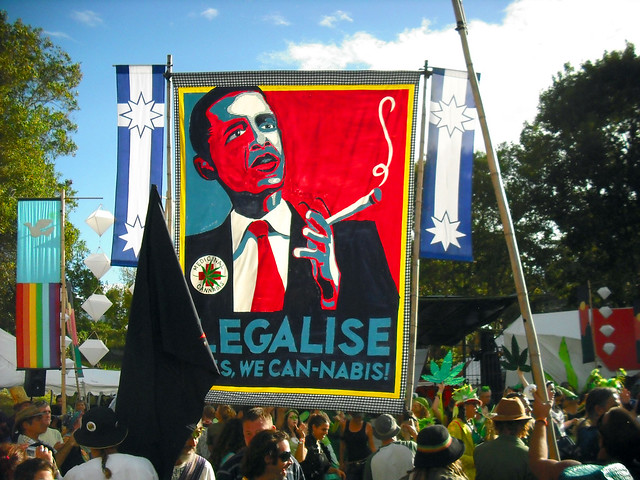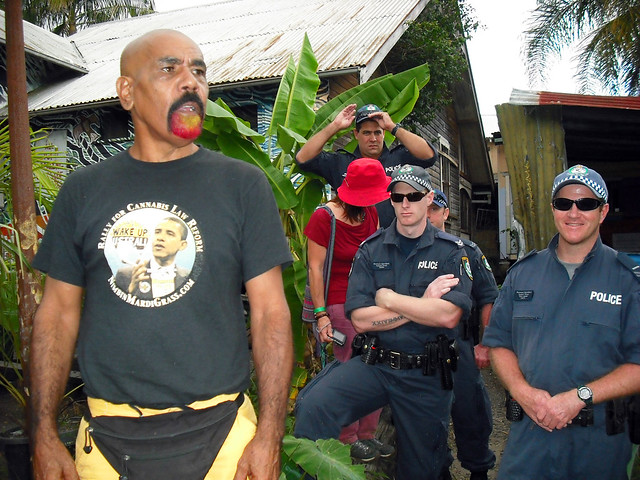US Marijuana Arrests Set New Record
For the fourth year in a row, US marijuana arrests set an all-time record, according to 2006 FBI Uniform Crime Reports. Marijuana arrests in 2006 totaled 829,627, an increase from 786,545 in 2005. At current rates, a marijuana smoker is arrested every thirty-eight seconds, with marijuana arrests comprising nearly 44 percent of all drug arrests in the United States. According to Allen St. Pierre, executive director of the National Organization for Reform of Marijuana Laws (NORML), over 8 million Americans have been arrested on marijuana charges during the past decade, while arrests for cocaine and heroine have declined sharply.
The number of arrests in 2006 increased more than 5.5 percent from 2005. Of the 829,627 arrests, 89 percent were for possession, not sale or manufacture. Possession arrests exceeded arrests for all violent crimes combined, as they have for years. The remaining offenders, including those growing for personal or medical use, were charged with sale and/or manufacturing.
A study of New York City marijuana arrests conducted by Queens College, released in April 2008, reports that between 1998 and 2007 the New York police arrested 374,900 people whose most serious crime was the lowest-level misdemeanor marijuana offense. That number is eight times higher than the number of arrests (45,300) from 1988 to 1997. Nearly 90 percent arrested between 1998 and 2007 were male, despite the fact that national studies show marijuana use roughly equal between men and women. And while national surveys show Whites are more likely to use marijuana than Blacks and Latinos, the New York study reported that 83 percent of those arrested were Black or Latino. Blacks accounted for 52 percent of the arrests, Latinos and other people of color accounted for 33 percent, while Whites accounted for only 15 percent.1
Over the years, roughly 30 percent of those arrested nationally have been under the age of twenty. The Midwest accounts for 57 percent of all marijuana-related arrests, while the region with the fewest arrests is the West, with 30 percent. This is possibly a result of the decriminalization of marijuana in western states, such as California, on the state and local level over the past several years.
“Enforcing marijuana prohibition . . . has led to the arrests of nearly 20 million Americans, regardless of the fact that some 94 million Americans acknowledge having used marijuana during their lives,” says St. Pierre.
In the last fifteen years, marijuana arrests have increased 188 percent, while public opinion is increasingly one of tolerance, and self-reported usage is basically unchanged. “The steady escalation of marijuana arrests is happening in direct defiance of public opinion,” according to Rob Kampia, executive director of the Marijuana Policy Project in Washington, DC, “Voters in communities all over the country—from Denver to Seattle, from Eureka Springs, Arkansas to Missoula County, Montana—have passed measures saying they don’t want marijuana arrests to be priority. Yet marijuana arrests have set an all-time record for four years running . . .”
Meanwhile, enforcing marijuana laws costs between $10 and $12 billion a year.

Citation
1. Jim Dwyer, “On Arrests, Demographics, and Marijuana,” New York Times, April 30, 2008.
UPDATE BY BRUCE MIRKEN
This story was essentially a subset of a larger annual story, the FBI’s yearly Uniform Crime Reports (UCR), and the 2006 report, released in September 2007, marked the fourth year in a row that marijuana arrests set a new record. While the UCR, as usual, got wide mainstream coverage, the only major mainstream outlet to note the marijuana arrest record was the Reuters wire service. Marijuana Policy Project staffers also did two or three local radio interviews, and the story was picked up in one form or another by a handful of other outlets—most notably Bill Steigerwald’s column in the conservative Pittsburgh Tribune-Review, an article on AlterNet, and Andrew Sullivan’s blog, The Daily Dish.
This is typical of the mass media tendency to view marijuana policy through the lens of Cheech-and-Chong stereotypes—as a trivial story of minor importance, more a curiosity than serious news. But the sheer numbers suggest it deserves more attention. Nearly 830,000 marijuana arrests are made annually, about 89 percent of them for simple possession, not sales or trafficking. That’s one marijuana arrest every thirty-eight seconds, and more arrests for marijuana possession than for all violent crimes combined. Put another way, it’s the equivalent of arresting every man, woman, and child in the state of North Dakota plus every man, woman, and child in Des Moines, Iowa, in one year—and doing the same thing every year, year after year. All of this comes at a total cost to taxpayers estimated at anywhere from $14 billion to $42 billion per year.
New national arrest statistics won’t be out until about the time this book is published, but scientific data continue to emerge that demolish the intellectual underpinnings of marijuana prohibition. Studies continue to find marijuana far less toxic or addictive than such legal drugs as alcohol and tobacco, while in Britain, where most marijuana possession arrests were discontinued in January 2004, marijuana use has steadily declined since arrests stopped, according to official government surveys. Sadly, even though the British government’s scientific advisors urge continuation of the no-arrest policy, as of this writing in May 2008, Prime Minister Gordon Brown appears determined to launch a new crackdown.
In the US, the clearest signs of progress have come from efforts to permit medical use of marijuana. Twelve states now have medical marijuana laws, and a medical marijuana initiative on Michigan’s November 2008 ballot was ahead by nearly two to one in the only public poll released so far. [When] Democratic presidential candidate, Barack Obama indicated he would end the federal war on these state medical marijuana laws, and fellow Democrat Hillary Clinton also indicated some willingness to rethink federal policy. Republican John McCain expressed support for current federal law.
Extensive information about marijuana policy and efforts to change our current laws is available from the Marijuana Policy Project, http://www.mpp.orgor (202) 462-5747. A more wide-ranging newsletter on drug policy issues is the Drug War Chronicle, at stopthedrugwar.org.
Since beginning my tenure at NORML in the mid-1990s, I’ve observed the growth of the annual number of Americans arrested for minor marijuana violations from a low of 288,000 in 1991 to a record 830,000 in 2006. Yet despite this nearly 300 percent increase in minor pot busts (nearly 90 percent of all marijuana arrests are for possession offenses), mainstream media coverage of these skyrocketing arrest rates remains nominal.
The media’s disinterest in this subject is uniquely troubling, given that the arrest data is derived from the FBI’s Uniform Crime Report, and that other aspects of this report (for example: has the violent crime rate risen or fallen?) traditionally generate hundreds of major news stories each year. Equally troubling is the media’s habit of improperly attributing these marijuana arrest figures to NORML rather than to the FBI, the law enforcement organization that actually tracks and reports said data.
Arguably, the most disturbing result of these rising arrests is that record numbers of Americans are now being ordered by the courts to attend ‘drug treatment’ programs for marijuana—regardless of whether they require treatment (most don’t) or not.
According to the most recent state and national statistics, up to 70 percent of all individuals in drug treatment for pot are now placed there by the criminal justice system. Of those enrolled in treatment, more than one in three hadn’t even used marijuana in the thirty days prior to their admission. Yet, disingenuously, the White House argues that these rising admission rates justify the need to continue arresting cannabis users—despite the fact that it is the policy, not the drug itself—that is actually fueling the spike in drug treatment.
Finally, it must be emphasized that criminal marijuana enforcement disproportionately impacts citizens by age—an all too often overlooked fact that has serious implications for those of us who work in drug policy reform. According to a 2005 study commissioned by the NORML Foundation, 74 percent of all Americans busted for pot are under age thirty, and one out of four are age eighteen or younger. Though these young people suffer the most under our current laws, they lack the financial means and political capital to effectively influence politicians to challenge them. Young people also lack the money to adequately fund the drug law reform movement at a level necessary to adequately represent and protect their interests. As a result, marijuana arrests continue to climb unabated, and few in the press—and even fewer lawmakers—feel any need or sufficient political pressure to address it.
(Paul Armentano is the deputy director of NORML and the NORML Foundation in Washington, DC.)
See the full list of Top 25 Censored Stories for 2009
Sources:
Marijuana Policy Project, September 27, 2007
Marijuana Policy Project, September 27, 2007
Title: “Marijuana Arrests Set New Record for Fourth Year in a Row”
Author: Bruce Mirken
Author: Bruce Mirken
National Organization for Reform of Marijuana Laws, September 24, 2007
Title: “Marijuana Arrests for Year 2006—829,625 Tops Record High”
Author: Paul Armentano
Title: “Marijuana Arrests for Year 2006—829,625 Tops Record High”
Author: Paul Armentano
Student Researchers: Ben Herzfeldt and Caitlyn Ioli
Faculty Advisor: Pat Jackson, PhD

Images - author's
For further enlightening information enter a word or phrase into the search box @ New Illuminati or click on any label/tag at the bottom of the page @ http://nexusilluminati.blogspot.com
And see
The Her(m)etic Hermit - http://hermetic.blog.com
New Illuminati – http://nexusilluminati.blogspot.com
New Illuminati on Facebook - http://www.facebook.com/pages/New-Illuminati/320674219559
This material is published under Creative Commons Copyright (unless an individual item is declared otherwise by copyright holder) – reproduction for non-profit use is permitted & encouraged, if you give attribution to the work & author - and please include a (preferably active) link to the original along with this notice. Feel free to make non-commercial hard (printed) or software copies or mirror sites - you never know how long something will stay glued to the web – but remember attribution! If you like what you see, please send a tiny donation or leave a comment – and thanks for reading this far…
From the New Illuminati – http://nexusilluminati.blogspot.com


Bonus Terbesar melalui Agen Capsa Dzerzhinsk Situs www.pokerusia.co Melalui BPD Sumbar Syariah Kode Bank 119.
ReplyDelete